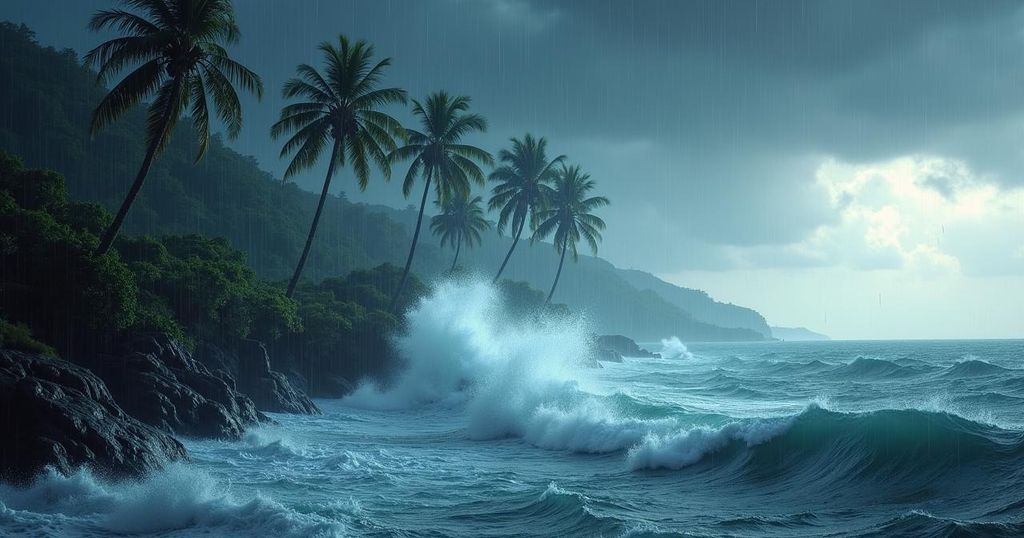Understanding Tropical Storms: Formation, Characteristics, and Impacts
Tropical storms are organized low-pressure systems occurring over warm ocean waters, with wind speeds ranging from 63 to 118 kilometers per hour. They act as intermediates between tropical depressions and stronger cyclones, being prevalent in various oceanic basins. Despite their lower intensity, tropical storms can still cause flooding and damage, particularly in coastal and low-lying areas. As a critical component of the cyclone development cycle, they warrant close monitoring.
A tropical storm is an organized weather system characterized by a low-pressure center that develops over warm tropical ocean waters. The typical sustained wind speeds of tropical storms range from 63 to 118 kilometers per hour (39 to 73 miles per hour). These storms serve as a transitional phase between less organized tropical depressions and more severe cyclones, which are categorized as hurricanes or typhoons depending on their location. Tropical storms can emerge in any of the Earth’s oceanic basins that experience tropical cyclones, including the North Atlantic, northeast Pacific, and Indian Oceans, among others. Structurally, tropical storms share similarities with more powerful cyclones but lack the pronounced eyewall feature that characterizes mature storms. They generally measure approximately 160 kilometers (100 miles) in diameter, with wind intensity peaking at altitudes between 30 to 50 kilometers (20 to 30 miles) from the storm’s center. The formation of tropical storms often begins with easterly waves originating in Africa, which travel westward and are marked by wind speeds of about 16 kilometers (10 miles per hour). Under certain atmospheric conditions conducive to convection, the system can achieve organization and growth. As warm air rises at the surface, it reduces local pressure, subsequently intensifying winds and promoting further heat transfer from the ocean surface. The Coriolis force, a consequence of Earth’s rotation, helps to establish a rotating wind pattern around the low-pressure center. In different oceanic regions, such as the western Pacific, tropical storms can develop from disorganized convection along the monsoon trough—a large area of low pressure spanning the equator. However, the exact processes triggering storm intensification remain somewhat ambiguous; it is suspected that surface pressure changes tied to upper-atmospheric troughs may contribute. A tropical storm is officially designated once wind speeds increase to 63 kilometers (39 miles) per hour. If these winds reach beyond 117 kilometers (73 miles) per hour, the storm is then classified as a hurricane, typhoon, or cyclone. Cyclones in the Atlantic and eastern Pacific are further categorized using the Saffir-Simpson scale, which evaluates their intensity and potential impacts, with Category 1 storms exceeding 119 kilometers (74 miles) per hour. Statistically, tropical storms are more prevalent than their more intense counterparts. For example, the annual averages for tropical storm formation in various ocean basins are approximately 13 in the North Atlantic, 16 in the northeastern Pacific, and 27 in the northwestern Pacific, with nearly 45 percent of these storms escalating to hurricane strength. However, tropical storms may not always gain intensity due to factors such as cooler sea temperatures, dry air aloft, or unfavorable wind shear that can hinder their vertical growth. Should a tropical storm encounter land before reaching hurricane strength, it may start to diminish quickly. While the damaging potential of tropical storms is considerably less severe compared to hurricanes, they can still inflict damage, especially in coastal and low-lying flood-prone regions. Typically, their winds create storm surges lower than four feet, and the primary destruction is usually limited to vegetation and unsecured structures. Nonetheless, the rainfall associated with these storms can lead to significant flooding and is a critical component of regional hydrological cycles.
Tropical storms are significant meteorological phenomena that emerge in tropical climates over warm oceanic waters. These storms represent a vital stage in the development of cyclone systems and have notable impacts on both the environment and human activities. Understanding their formation, characteristics, and potential consequences is essential for effective storm prediction and preparedness measures, particularly in regions that regularly experience such weather patterns. Due to their transitional nature, tropical storms are often precursors to more intense tropical cyclones, making their study crucial for scientific and practical applications related to severe weather management.
In summary, tropical storms are a key weather phenomenon characterized by organized low-pressure systems over warm ocean waters, featuring sustained winds between 63 to 118 kilometers per hour. They occupy a critical position in the cyclone development scale and can significantly impact regions prone to heavy rainfall and flooding. While they generally cause less damage than hurricanes, they still present hazards, particularly in vulnerable areas. Monitoring and understanding the characteristics and behavior of tropical storms is imperative for disaster preparedness and climate studies.
Original Source: www.britannica.com




Post Comment